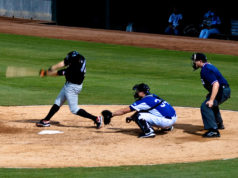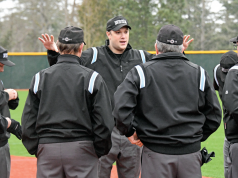By Jon Bible
Last season, I was watching an MLB game and the plate umpire — I forget who it was — was giving the location on pitches he balled. Now, as most everyone knows, plate umpires are often put on microphones so the public can hear what’s being said. He was saying, “Ball inside,” “Ball up,” etc. The reason it caught my attention was that is what I always had done but I know a lot of people oppose the concept and the only major league umpire I ever remember doing it was the late Lee Weyer.
There is one school of thought that says if we verbally announce the location of a ball, we’re inviting challenges. For me to say, “Ball, low” — or, in my case, “No, it’s down” — is, in other words, calculated to draw from the defensive dugout a, “What do you mean, low? That was right there!” or some such blather. And I do see the merit of that argument.
But I always figured that I can deal with retorts like that one just as I can any other kind of challenge on a pitch call — by putting my hand up, as if to say, “I heard you; no more,” and, if need be, going to the next step and issuing a ball-strike warning (as allowed by NCAA rules). To me, in other words, there was never really any downside to making a verbal announcement, and I always thought there was an upside.
On the pitches that are up and down, when the dugout has a pretty good idea of whether the height of the pitch is good, your announcement at least lets them know what you thought. They may not agree with the fact that you said the pitch was low, but at least there is no need for them to yell, “Where was it?” And on the pitches that are in and out, when the dugout has no clue if the pitch is over the plate except by trying to read the catcher’s motion and how he frames the pitch, I think that many, many times in my career I staved off challenges by saying, “No, it’s inside,” or, “That’s outside.”
They may have thought, “That looked good,” but when they heard me they said, “Oh, OK.” I never did it on the real obvious misses, just the close ones. Sometimes I reinforced my call by looking outside with my head and eyes on pitches off the outside corner and toward the inside on the inside pitches. All part of the selling process, in my book.
To look at the other side of the coin, I’ve witnessed many instances in which an umpire did not announce the location and someone said, “Where was it?” The umpire then gave some subtle indication by motioning or pointing down, up, in, etc., only to have the questioner say, “No way.” Then the only realistic response from the umpire is, “If you’re not going to believe me, why ask?” My point is that either way, whether you announce the pitch location or not, there may be some comeback, so neither method is foolproof. That being the case, I’ll stay with the method that I think helps me more than it hurts.
I’ve always thought there are a lot of areas in officiating in which there is no necessarily right or wrong approach, just differences of opinion about how things should be done. My good friend Randy Christal, for example, has taken every single play at first base in foul territory for the 38 years that I’ve worked with him — in two-man crews up to six — just like the longtime AL umpire Bill Haller did for more than 20 years. Not textbook, to be sure, but I don’t remember the last time I saw Christal miss one.
Same thing here.
Some umpires like, “Ball,” “Strike,” and that’s it. Others, like me, like to announce the location. As I noted, I never thought it hurt me in any way, and I thought that many times it helped keep people off my back.
What's Your Call? Leave a Comment:
Note: This article is archival in nature. Rules, interpretations, mechanics, philosophies and other information may or may not be correct for the current year.
This article is the copyright of ©Referee Enterprises, Inc., and may not be republished in whole or in part online, in print or in any capacity without expressed written permission from Referee. The article is made available for educational use by individuals.


















